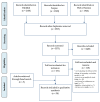Increasing HPV Vaccination Uptake among Adolescents: A Systematic Review
- PMID: 33143171
- PMCID: PMC7663345
- DOI: 10.3390/ijerph17217997
Increasing HPV Vaccination Uptake among Adolescents: A Systematic Review
Abstract
Human Papillomavirus (HPV) vaccination is a well-known fundamental strategy in the prevention of cervical cancer, as it is always caused by HPV infection. In fact, primary prevention of the infection corresponds to primary prevention of HPV-related cancers and other diseases. Since an effective prevention at the population level is the final goal, it is mandatory for healthcare systems to achieve a high HPV vaccination coverage among the adolescents to reduce the circulation of the virus and the burden of HPV-related diseases. This research identified, through a systematic literature review, 38 papers on strategies adopted to increase HPV vaccination coverage among adolescents. The evaluated strategies targeted adolescents/parents and/or healthcare providers and could be grouped in three main types: (1) reminder-based, (2) education, information, and communication activities, and (3) multicomponent strategies. Several types of strategy, such as those relied only on reminders and integrating different interventions, showed a positive impact on vaccination coverage. Nonetheless, the heterogeneity of the interventions suggests the importance to adapt such strategies to the specific national/local contexts to maximize vaccination coverage.
Keywords: HPV vaccination; increasing coverage; systematic review.
Conflict of interest statement
The authors declare no conflict of interest. The funders had no role in the design of the study; in the collection, analyses, or interpretation of data; in the writing of the manuscript, or in the decision to publish the results.
Figures
References
-
- Rodríguez A.C., Schiffman M., Herrero R., Wacholder S., Hildesheim A., Castle P.E., Solomon D., Burk R. On behalf of the Proyecto Epidemiológico Guanacaste Group. Rapid clearance of human papillomavirus and implications for clinical focus on persistent infections. J. Natl. Cancer Inst. 2008;100:513–517. doi: 10.1093/jnci/djn044. - DOI - PMC - PubMed
-
- Bruni L., Diaz M., Barrionuevo-Rosas L., Herrero R., Bray F., Bosch F.X., de Sanjosé S., Castellsagué X. Global estimates of human papillomavirus vaccination coverage by region and income level: A pooled analysis. Lancet Glob. Health. 2016;4:e453–e463. doi: 10.1016/S2214-109X(16)30099-7. - DOI - PubMed
-
- IARC IARC working group on the evaluation of carcinogenic risks to humans. IARC Monogr. Eval. Carcinog. Risks Hum. 2012;61:45–119.
Publication types
MeSH terms
Substances
LinkOut - more resources
Full Text Sources
Medical


